Nihon Sayonara!
Previous Japan Letter | Japan
Snapshots | Japan Letter Index | Home
Page | contact
- JAPAN LETTER #5
- (Fifth and Final Japan Letter!)
Well, here I am! I began writing this letter about four days
before my departure from Tokyo after six months of living there. Now,
I sit here in my San Francisco loft putting the finishing touches on
it. I flew home on the 10th and, having lived through two Saturdays
(one in Tokyo and one in San Francisco), I forced myself to stay up
through the second evening of the same day and went to see a
wonderful performance by eight Bay Area improvisers at Meridian
Gallery. It was a delight to see so many friends and collegues all at
once after being away for so long. A few days later, I flew to LA to
retrieve "Yoko" (my Honda hatchback) from her safe place in my
sister's driveway. I stayed there for a few very hot days basking in
a pool and missing the whole KPFA incident (an historical event
which, if you haven't heard, I recommend that you look into it!) and
then drove back up to SF. Now, in an attempt to possibly put some
closure on a very momentous six month journey (or possibly to make a
smooth segue into the coming days back here at home), and of course
to give you the low-down on the last part of my stay, I am sending
you this last report on my adventures.
July 6-10, 1999
FINAL MONTH
The last month of my Japan Fellowship has been possibly the most
insane! One tries to fit everything into the last few weeks, and one
almost succeeds! It's been rush rush rush! Hurry up and see
everything I meant to see during the first five months! Hurry up and
and see all my new friends to say goodbye and exchange omiage! Even
hurry up and do relaxing things I was too busy to get around to
before like spending a weekend in Kyoto, and going to Hakone to soak
in the onsen. My goodness! Even considering how crazy my life
usually is at home, it's been a record 6 months for insane schedules.
And I think that this final month should make the Guinness book.
|
I had three public performances this month. (Four if you
count the Internet performance.) (Five if you count the
Karaoke bar!) And I did a lecture/demo at Keio University
Mita Campus on top of all of that. Squeezed in between all
those performances were activities like attending more Noh
and Butoh workshops, taking private Japanese singing
lessons, attending a number of public performances of
experimental and traditional works, seeing Japanese
independent films at the I-House, trying to have lunch,
dinner, or at least a sake with as many of my friends as
possible, good old fashioned sightseeing, and feverish
shopping for small omiage (souvenirs).
|
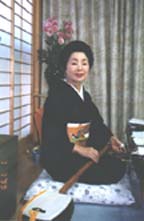
Rick Dyck's Japanese Singing
Teacher
|
NEW WORK (Keitai piece).
One of the new works I created here in Japan is called "Keitai".
It is scored for portable phones, and had it's first performance at
the International House on May 17th. However, an even stronger
performance of it occurred a month later when I did my lec-dem at
Keio. As I mentioned before, everyone in Japan carries a
keitai (portable) phone. That was, of course, a slight
exaggeration, but only slight. And I have found that the younger the
group of people, the higher the percentage of keitai owners.
In a group of mixed age such as the attendees of my I-House
performance, the number seemed to be around 50%. But in an auditorium
full of college students, I found that the portion of people carrying
keitai appeared to be around 80%! In an audience of around
200, this made for a very lively performance of the piece. The score
for "Keitai" consists of a small slip of either pink or green paper
that is placed on each seat before the audience enters. The paper
reads (in Japanese): "If you are carrying a keitai, please
write the phone number here." When the audience arrives, rather than
the usual announcement at performances reminding them to turn their
phones off, there is an announcement asking them to turn them on.
After people have had time to write down their phone numbers, the
slips of paper are collected and redistributed- the pink ones going
to the the people who previously had green and vice versa. The piece
is in two movements: "Midori" (Green) and "Pinku" (Pink). On my
signal, the people with green slips of paper are asked to dial the
number written there. After letting their phones ring as long as
possible before the voicemail kicks in, the other people are to
answer their phones and loudly saying "Moshi moshi! ("Hello!") I'm
sorry, but I can't talk right now. I'm in a concert." When all the
keitai activity is finished, the same actions are repeated for
the second movement, with the pink slip people dialing and the others
responding.
The resulting cacophony is quite a bit more interesting in Japan
than it would be in the States. The reason for this is not only the
greater prevalence of portable phone owners, but also the fact that
Japanese keitai don't just have normal phone rings. They are
all equipped with a menu of little songs the user can choose from,
and some of them are even programmable- allowing the user to write
their own personal melody. When a keitei rings in Japan, you
are just as likely to hear "It's a small World After All", "The Theme
from Star Wars", "Hey Jude", or "Twinkle Twinkle" as you are to hear
the standard little "Brrrrrrrrr" sound that is the default. My
personal favorite right now is "Beethoven's 9th". Once, mine went off
in an elevator and a man standing next to me smiled to his wife and
said "Dai Kyuu!" (Which means "Big Nine", the Japanese' affectionate
name for the 9th). (Don't worry, by the way. My phone won't work in
the US. I'll return to less toxic means of communication when I get
back home.) Anyway, you can imagine the formidable sound that
resulted from a room full of those all going off at once!
KARAOKE!
As I mentioned in previous letters, I have been on a mission to
get some experience in Japanese traditional styles of singing. During
my final month in Japan, I finally found someone who could teach me.
Etsuko started out teaching me traditional Japanese songs. She would
accompany me on shamisen, and we worked in a kind of call and
response method, because there were no scores written in a format
that I could readily understand. At one point I mentioned to her that
I would even enjoy learning an enka song. Enka is the
sentimental style of pop song that is often heard on television
variety programs and in karaoke bars. The lyrics are usually
sad, the orchestration is elaborately souped-up and the melodies
emotional. Most foreigners and Japanese young people think enka is
really kind of schlocky, uninteresting music. I've always kind of
secretly liked it. Partially for it's somewhat kitsch nature, and
partially because I hear something in the singing technique that, to
me, sounds deeply rooted in other more ancient and traditional
Japanese singing styles. Something in the powerful gutsy low end, the
bright high end, and the shamelessly wide vibrato on the sustained
notes that I find seductive.
|
Etsuko (who also plays traditional music and experimental
music) agrees with me and really loves enka. As soon
as I brought it up, she became very enthusiastic about
teaching it to me, and gave me a popular enka song to
work on.
So, as a kind of celebration of my having mastered one
song, and as a sort of good-bye party for me, we went out
for karaoke on one night during my last week in
Tokyo. I twisted two of my friends' arms (Maya and Maureen)
to come with us after Noh class. Both of them said
they hated karaoke and didn't think they'd enjoy
themselves but they would try. No one else we had invited
could come, so it was just me, Etsuko, Maya, and Maureen. We
had a blast! We started out with enka.
|
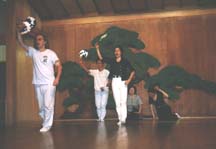
Noh Class
|
Etsuko did a fabulous performance of some really popular number that
none of the rest us knew. Then we just traded off choosing songs. We
alternated Elvis Presley and Prince with enka songs (all with
the karaoke machine's wonderfully excessive reverb). We were
trying to find the most overwrought, karaoke-friendly pop
songs possible. I sang my only enka song "Chanchiki Okesa". We
all leafed furiously through the songbooks, which were listed
alphabetically by the Japanese phonetic alphabet. Beatles songs by
the scores, but the only one we felt like singing ("I am the Walrus")
wasn't in there. Then, suddenly, we all hit on it! The perfect
karaoke song! Queen: "Bohemian Rhapsody"! After adjusting the
key up and down till it was just right for our ranges, all four of us
wailed on it! "....Mama, life had just begun- and now I've gone and
thrown it all away! Mama, oooooo, didn't mean to make you cry! If I'm
not back before this time tomorrow, carry on, carry on. It doesn't
really matter..." The people at the karaoke place eventually
had to throw us out. We sang one last round of "Chanchiki Okesa" and
then walked back to the subway laughing. Maya and Maureen were
exchanging phone numbers with Etsuko and saying they wanted to learn
to sing enka.
JAPANESE DESIGNERS
I will actually really miss the fashionable Aoyama shopping area
which is so near my home. I often walked through it when coming home
from the Omote Sandou subway station, and I spent some time visiting
the designer clothing shops. I have always had a love of excentric
garments, and when I was younger, I used to sew all my own clothes so
that I could own extravagant fashions that I could never afford to
buy. In later years, I became so consumed by crazy schedules that I
was unable to do that. Visiting these stores so frequently has
reawakened that part of me to the extent that I really think I will
try to carve out the time to do it again. I loved visiting shops like
Kenzo and Issey Miyaki, but I think my favorite was Yohji Yamamoto.
These shops are really more like art galleries to me than stores. I
find the incredible and sometimes impossible garments and the way
they are displayed to be very stimulating in a way similar to
visiting an installation of sculpture or conceptual art objects. The
more impossible they seemed to wear, the more intrigued I was by
them, and determined to create and use something like them (as
costumes or actual streetwear!). I made mental notes on Issey
Miyaki's triangular and square (sometimes plastic and paper)
garments, and Yohji Yamamoto's unfinished tailored suits with huge
milliner's wire hoops in their hemlines. I'm just brimming with ideas
now! I sometimes think that seeing work in other media inspires and
influences me just as much if not more than seeing sound and
performance works.
OUT OF THE CITY!
|
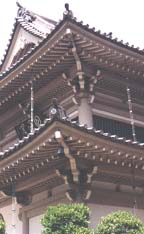 Kenchouji
Temple Kenchouji
Temple
|
During my last week and a half in Japan, I finally spent
some time out of Tokyo. The last of my performances- a
shared concert with shou player Tamami Tono- was held
at Kenchouji Temple in Kamakura. I went there a week earlier
with Tamami to meet with the people who were sponsoring the
event, see the temple, and do a little sight-seeing in
Kamakura. We were just in time for the blooming of huge
purple and blue hydrangeas that are famous there. I also got
to see a bamboo forest. I was amazed at the tall, thick,
elegant stalks. Tamami pointed out to me the baby bamboo
trees that were sprouting below and said that those are the
ones we eat! Kenchouji Temple itself was quite beautiful,
and it was a pleasure coming back there on the fourth to do
a concert of traditional Gagaku music and modern
electronic music. Tamami and I each performed solo
electroacoustic works, Tamami did some traditional
Gagaku pieces with two other musicians, and we all
performed together on a piece by Takemitsu. I also had to
learn two traditional Japanese melodies which I sang for the
opening and closing pieces of the event.
|
|
I had an actual vacation (albiet short) in Kyoto. I went
(with Tamami) during the last weekend in June. I spent the
night in a ryokan (a traditional Japanese bed and
breakfast) in the famous Gion district. I was served
beautiful meals at a low table in my tatami room,
which also had a private wooden Japanese furo (bath).
After dinner, while I was enjoying the lovely tearoom
downstairs, the maid came in my room and made ready a
futon for me to sleep on. I visited many beautiful
temples and shrines (including Ryoanji with its famous "Zen
Garden") and did a lot of shopping, and in the evening I
took a short stroll through the streets of Gion. I saw a
young geisha come out of one of the teahouses, and
asked her if she'd mind my taking her picture. Just as I was
about to snap, two Japanese girls offered to take my picture
with her. All this took place in the pouring rain- for it's
rainy season in Japan. So the photo is of the two of us- she
with her bamboo and paper parasol, and me with my MOMA cloud
umbrella. An unlikely pair, we definitely look like we come
from two very different periods in history.
|
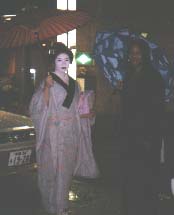
|
In my last week, my friend Misako took me to Hakone Springs to spend
a day soaking in an outdoor onsen. Maureen also came along and
Misako's husband Tomoe ("Akihabara King") joined us later. It was a
wonderful, relaxing day moving from one hot pool to another. One of
the pools was inside a cave, and Maureen and I experimented with
singing pitches to find the most resonant pitch of the cave. In the
sauna, we chatted with some women who were fascinated that I was a
singer and insisted that I sing something. Maureen joined them in
urging me on, so I finally did. Then, to get back at her, I said,
"Well you know, Maureen is a dancer. Maureen, why don't you dance for
the ladies?" She was, of course, too embarrassed to do so naked at a
public bathhouse, so she sang a Noh song instead.
|
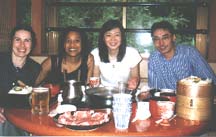
|
Tomoe, who had been on the men's side, met us afterwards,
and we all had dinner together at the Ten-san onsen's
restaurant and then returned to Tokyo for a Min Tanaka Butoh
performance.
|
SAYONARA!
My last days in Japan were filled with warm goodbyes and
incredibly kind gestures. All of my friends wanted to see me and say
goodbye in some way. And, just as I was warned, everyone started
giving me things. Even up to the last minute- I was receiving gifts
from my friends. Misako and Tomoe, who offered to take me to the
airport, asked me to spend the night with them before I left. After
helping me cancel my portable phone account, they started by taking
me to Tomoe's mother's home (also the mother of Hatsune Otsu of
"Visual Brains"). Otsu-san, in true mother style, tried to feed all
of us, even though we had dinner reservations for later that
evening.
|
Then, she dressed me in the kimono that was given
to me by my teacher- all the while giving instructions about
how to tie the obi and how to wear the undergarments
that go with the kimono. Hatsune and Sei were there,
and they were videotaping the entire proceedings so that I'd
have a record of it, and could remind myself of the lesson.
Because I didn't have the under-kimono or the little
pillow that is used to give loft to the back of the
obi (like a little bustle), Ohtsu-san insisted on
giving me old ones of hers. I thanked her profusely while
fretting to myself about how I was going to fit the items
into my already over-stuffed luggage.
|

|
After my kimono lesson, we proceeded to a wonderful little
sushi-ya where Misako, Tomoe, and myself sampled many
delicacies while downing a lot of hot sake. One of the more
striking looking dishes was uni (sea urchin) which looked like
a cross between a porcupine and an acorn squash! We finished with
green tea aisu kurimu (ice cream). And then went back to their
place for a good night's sleep. In the morning, they took me on a
tour of some historic old traditional Japanese-style houses and rice
farms. Then we went to a shopping center so I could do some last
minute shopping (for more things to stuff into my luggage). Then on
to the airport, where we enjoyed a last meal together with an old
friend of Misako's who was very helpful to me in organizing my flight
and luggage arrangements. I was so filled with gratitude by the time
I got on the plane. Narita is so far from the city that no-one
usually ever gets picked up or dropped off at the airport. People
generally have their luggage delivered by a "takubin" service
and then take a train or bus to the airport. I was really given royal
treatment by my friends!
HOME
Now here I am, putting the finishing touches on this last "Japan
Letter". So far, the culture shock hasn't been so bad. Mainly trying
to learn to stop bowing constantly, and saying things like
"Sumimasen" (Excuse me) and "Doumo arigatou gozaimasu!"
(Thank you very much!). I also have to remember to leave a tip at
restaurants, not to look the wrong way when I walk out into the
street, and not to leave my purse and valuables unattended in public
for even a moment. But I think that just the fact of being here will
bring those things back pretty quickly. I'm more worried about not
wanting to lose some of the changes that have occurred in me. The
most obvious of those might be my ability to speak and understand a
little Japanese, but there are more subtle things that are more
difficult to pinpoint and very hard to articulate here. I think I
will be quietly making constant comparisons between Japanese ways and
American ways for some time. There's one discovery that I wasn't able
to make until returning home. There are many things which I was
introduced to in Japan and thought only existed in Japan. Coming back
here I discovered that some of those things do exist here as well,
but it just took my going to Japan to see them for the first time. I
think that traveling and experiencing new places and cultures tends
to make the world seem a little more seamless. There are borders, but
there is a lot of overlap and bleed-through across them. Once you
know that something exists in one place, whether its a food, a style,
or an attitude, you can find it anywhere on the planet if you look
hard enough.
ONE LAST ANECDOTE
As I have mentioned before, I have been getting a big kick out of
some of peculiar examples of Japanese use of English language in
advertising and product names (like "Let's Kiosk", "Just Spot", and
"Beer Water"). I always wondered why the companies that select these
names don't consult a native English speaker when making their
choices. Well, it turns out that they probably do, but in the end,
they go with what sounds the best to them. At one point, early in my
stay, my friends (our heroes Misako and Tomoe a.k.a. Akihabara King)
approached me for some assistance. They told me that they were
starting a school for television related media. They would teach
courses in things like digital video editing, script writing,
Photoshop, etc. (If I didn't mention it before, Akihabara King gets
his nickname from a neighborhood in Tokyo called "Akihabara" where
all the big electronics and appliance stores are located. It's our
affectionate way of calling Tomoe a geek.) They wanted to name the
school using some English words ("because it's cool") and wanted to
run some of their ideas past me.
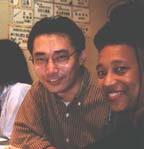
The Akihabara King and
I
|
Apparently they had done some web searches in hopes of
finding some good language to use. Their first choice for a
name was "Work Study Program". I laughed and explained to
them that this was not an attractive name for a media
school, or at least not to an English-speaking person. "Why
not?" "Well, first of all, because it draws up memories of a
job you had to do while attending college and you didn't
even get to keep the money!" Their other choices were all
equally awkward and/or unappealing, so they asked me to make
a suggestion. I suggested that they use something with the
word "Media" in it. And I added that the use of the word
"Laboratory" was considered kind of hip. They liked the
"Laboratory" idea.
|
I also mentioned that it could be shortened to "Lab". "You know,
something like Media Lab" Well they instantly liked this, but they
were worried that people wouldn't be able to tell from the name that
it's a school. So they asked "How about calling it Laboratory
School?" I explained that this was very awkward and didn't really
make sense. So we went round and round like this for quite a while
until they came back to me and finally said "We've thought it over
and we've decided we like your name MediaLab, and we're going to go
with that. And we want to give you credit for the name…" Well,
of course I was quite embarrassed at this point and said, "Really, it
was nothing. I'm sure, in fact, that there are organizations in the
States that have, well, similar names…" But they had checked and
found there to be no "Media Lab" in Japan and that's what they would
use. Then, a few months later, after I had forgotten about it, they
came back to me. They took me out to dinner and said there was
something serious they needed to discuss with me. Over dinner they
looked at me with concern and asked if I thought it would be OK to
call it "The Media Lab"? I could barely contain my laughter. I told
them that if they really liked that better, there was no reason why
they couldn't use "the", but in my opinion it sounded better without
"the". Then they asked "Well how about 'A Media Lab'?" On this I was
quite firm. If you must use an article, "the" is definitely better
than "a". But why were they so insistent on adding an article? Well
it turns out that Tomoe's father had analyzed the number of strokes
required to write "MediaLab" and it was a very unlucky number! I had
never heard of anyone counting stokes when the words are not written
in Japanese characters. I wouldn't even know how they are counted.
But I said, "It's ok. Don't worry. If 'The Media Lab' sounds good to
you, than I'm sure it will sound fine to other Japanese people. It's
ok to use 'the' in the name." They were relieved and went away
satisfied with the new name for their school. Of course with that
episode I cant help but to wonder whether there isn't a similar story
behind the naming of "Let's Kiosk!"
pz
Top | Previous
Japan Letter | Japan Snapshots | Japan
Letter Index | Home Page
| contact


 Kenchouji
Temple
Kenchouji
Temple


